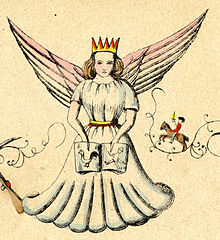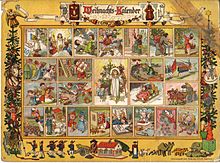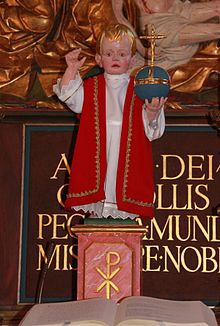Christ child


The Christ Child is a symbol of the Christmas festival , which , according to tradition , brings Christmas presents to children without being seen. Originally a Protestant tradition, the idea of the Christ Child is now predominantly widespread in Catholic areas, especially in southern and western Germany , Alsace , Luxembourg , Austria and Upper Silesia in present-day Poland, South Tyrol , German-speaking Switzerland , Hungary , the Czech Republic , Slovakia , Slovenia and Croatia as well as southern Brazil . The Christ Child is often depicted as a blond, curly haired child with wings and a halo .
Since the High Middle Ages , sculptures depicting the Child Jesus have been known as devotional images, which art history calls the Christ Child . Such Christ children are also the focus of the Christkindlweighing . The figure of the baby Jesus in the nativity scene is popularly referred to as the Christ Child .
The Christ Child as a gift bringer
history
In the Middle Ages, gifts were given to children on St. Nicholas Day (December 6th) or on the Day of Innocent Children (December 28th); the mess on Christmas Eve or on Christmas Day, as is common today, did not exist then. However, the Protestants rejected the veneration of saints - and thus also the veneration of St. Nicholas. It is therefore very likely that Martin Luther replaced Nicholas in the 16th century with the "holy Christ" ( Jesus Christ ) and moved the gift to December 25th. In other places - such as in Reformed Switzerland - gifts were given on New Year's Day until the 19th century . Over the years the term "Christ Child" and the idea of an angelic appearance developed. The Christ Child became increasingly independent and the connection to Jesus Christ became more and more unclear. In Reformed Switzerland it became - according to the (formerly) valid day of the present day - the New Year's child . The angel-like representation probably has its origin in Christmas moving customs and nativity scenes, in which a crowd of angels was often led by a "Christ Child". The Christ Child first spread in Protestant Germany. The custom later spread to the Rhineland, then, together with the Advent wreath and Christmas tree, to Bavaria and Austria.
This line of development was crossed by two opposing directions: On the one hand, the Christ Child in Northern and parts of Central Germany was increasingly being replaced by Santa Claus among Protestants, and on the other hand, the Christ Child in Switzerland was increasingly displacing St. Nicholas (Chlaus) . It was not only in Catholic but also in parts of Reformed Switzerland in the 18th and 19th centuries that Chlaus brought the presents around Christmas or on New Year's Eve. At the end of the 19th century in Reformed Switzerland, the Christ Child was still perceived in some places as "Catholic" or as an import from Catholic southern Germany. In the 20th century, however, St. Nicholas was ousted by the Christ Child here too. Thus, the Christ Child is a gift-bringer mainly in predominantly Catholic areas such as Austria, Bavaria, Saarland, the Catholic parts of Baden-Württemberg, Westphalia and the Rhineland, but also in the traditionally Protestant regions of Franconia, Baden-Württemberg, the Palatinate and Hesse as well widespread in German-speaking Switzerland.
Customs in the present
Children's mail to the Christ Child
In the run-up to Christmas, many children send letters with wishes to the Christ Child. These have been collected and mostly answered in the Upper Austrian Christkindl , a district of Steyr , since 1950. This Christkindl post office is open every year and stamps the letters that are sent through it with a special stamp . Every year around two million items receive this stamp. The highest Christkindl post office in Austria is on the Pitztal Glacier in Tyrol at an altitude of 3,440 m. Every year from 20. – 23. December children can send their mail to the Christ Child in Café 3440 there and put it in the mailbox.
In Germany, letters to the Christ Child are sent to one of the Deutsche Post AG Christmas post offices.
In Switzerland, as part of the Christkind campaign, Swiss Post answers over 17,000 children's letters every year that were sent to the Christkind or Santa Claus.
Nuremberg Christ Child
On the occasion of the Nuremberg Christkindlesmarkt there has been an annual Christkind since 1933, which was played by actresses until 1968. Since 1969, a young woman from the city, who must be at least sixteen years old, has been elected to be the Christ Child every two years. In costume, she opens the Christkindlesmarkt in the city and then travels through Franconia to visit Christmas and Advent events. In the Nuremberg costume representation, the Christ Child is a young woman with blond curly hair, a crown and a white and gold angelic dress. The Nuremberg Christkind also opens the Christkindlesmarkt in Chicago .
The Christ Child as a Jesus figure

In the history of art, the isolated image of the little Jesus boy is referred to as the Christ Child ; further terms for it are holy child, kindli, Jesulein, Jesusknäblein, Bornkinnel or Bornkindl. It is usually depicted without additional figures and outside of any scenic context or as a baby in a baby and in a cradle, possibly lying in the crib or cradle ( fatschenkind ).
In some places it is the custom that the figure of the Christ Child is carried in a procession to the Christmas crib in the church at the beginning of the Christmas mass and is placed there by the priest in the crib.
The oldest and most common form of the Christ child is that of the standing, naked, about one year old Jesus boy. The earliest known or surviving portraits date from around 1300. During the Christmas season in particular, such figures were placed at the altar in monasteries and churches for worship and included in spiritual cradle games as if they were living beings. Religious women sewed garments for the figures and embroidered them. Standing figures of the Child Jesus with a blessing hand and orb also became important . These figures included the Bambino in the Roman church of Santa Maria in Aracoeli and the Infant Jesus of Prague , which were often copied.
Other meanings
Colloquially, people who have their birthday on December 24th are also referred to as "Christ children". In parts of the regions where the Christ Child brings the gifts, the gifts themselves are sometimes referred to as the Christ Child .
See also
literature
- Angelika Breunig: Bring yourself many gifts ... - On the cultural history of the Christmas present. (= Booklet accompanying the exhibition of the same name in the Museum Malerwinkelhaus Marktbreit , November 21, 2009 to January 17, 2010). Museum Malerwinkelhaus, Marktbreit 2009, DNB 1013333926 , pp. 10–12.
- Ingeborg Weber-Kellermann : The Christmas party. A cultural and social history of the Christmas season. 2nd Edition. Bucher, Munich 1987, ISBN 3-7658-0273-5 , pp. 98-102.
- Michael Kotsch : Christmas. Origin, sense and nonsense of Christmas customs. Jota, Hammerbrücke 2003, ISBN 3-935707-15-0 , p. 108.
- Alfred Läpple : Small Lexicon of Christian Customs. Pattloch, Augsburg 1996, ISBN 3-629-00679-5 , pp. 43-44.
- Thomas Ludewig (Ed.): Christkind, Santa Claus & Co. - Cultural history about the Christmas gifts. (= Publication accompanying the special exhibition of the same name in the Clemens Sels Museum Neuss , November 29, 2007 to January 27, 2008). Clemens Sels Museum, Neuss 2007, ISBN 978-3-936542-35-6 , pp. 55-69.
- New-Jâr-Chindli . In: Schweizerisches Idiotikon . Volume 3. Huber, Frauenfeld 1892, column 346.
- Christ-Chindli . In: Schweizerisches Idiotikon . Volume 3. Huber, Frauenfeld 1892, columns 346-347.
Web links
- Christ Child - symbolic figure of Christmas . In: Weihnachtszeit.net
- Tobias Glenz: The story of the Christ Child . In: Katholisch.de , December 22, 2019
- Markus Bechtold: Martin Luther's Christ Child ousted St. Nicholas . In: Evangelisch.de , December 6, 2019
- Christoph Landolt : Nicholas, Christ Child, Christmas Child, New Year Child, Mutti, Pelzer & Santa Claus . In: Wortgeschichte from December 19, 2013, ed. from the editors of the Swiss Idiotikon
Individual evidence
- ↑ Christ Child. University of Augsburg, July 26, 2016, accessed on December 23, 2018 .
- ↑ For 91% of Austrians, symbolically speaking, the Christ Child brings the presents (7% Santa Claus, 2% no answer). market survey: CATI telephone interviews, representative of the Austrian population aged 16 and over, n = 418, survey period December 11 to 12, 2012: Conrad Seidl: Survey: Dalai Lama gives more religious direction than the Pope. In: derStandard.at . December 23, 2012, accessed December 23, 2018 .
- ↑ Ljubomir Škrinjar: Hrvatska Svjetla i tame: Božićne jaslice u našim crkvama. In: Portal Hrvatskoga kulturnog vijeća (Portal of the Croatian Culture Council). December 29, 2010, accessed December 23, 2018 (Croatian).
- ↑ Lissi Bender Azambuja: Christmas, Natal - O evento mais marcante do ano. In: Brasil Alemanha. Archived from the original on October 4, 2013 ; Retrieved December 23, 2018 (Portuguese).
- ↑ Ingeborg Weber-Kellermann: Das Weihnachtsfest , p. 98: "The gift-bringing Christ child is by no means identical with the newborn redeemer child in the cradle [...]"
- ↑ a b Hans Wentzel: Christ Child . In: Real Lexicon on German Art History . tape III , 1953, col. 590–608 ( rdklabor.de [accessed December 23, 2018]).
-
↑ Renate Krüger-Behrens: The Christmas crib. In: Website of the Evangelical Lutheran Church of Hanover. December 20, 2011, accessed December 23, 2018 . Christmas market in Greifswald: thieves steal the Christ Child from the crib. In: Spiegel Online . December 17, 2015, accessed December 23, 2018 . The Christmas crib - three-dimensionally staged faith 6.1. In: needum.de . Retrieved December 23, 2018 .
- ↑ a b Chlaus . In: Schweizerisches Idiotikon . tape III . Frauenfeld 1893, Sp. 687–697 ( idiotikon.ch - with further information).
- ↑ Michael Kotsch: Christmas - Origin, Sense and Nonsense of Christmas Customs , p. 108: “On the one hand, thanks for the good gifts should not be brought to a person but to Jesus Christ himself. On the other hand, the gifts were now even more seen as images of God's great gift for humanity. God sends his Son Jesus Christ to bring real joy, deep peace, and real forgiveness of their guilt to people. That is why people give gifts to each other. In doing so, they follow God's example, they express their gratitude to him, they want to give others a share in their joy and in doing so they symbolically point to God's gift. "
- ↑ Ingeborg Weber-Kellermann: Das Weihnachtsfest , p. 98: “[…] because Luther tried to push back the popular church saint Saint Nicholas and his cultural area and to replace it with the 'Holy Christ'. Such a bloodless and faceless anonymous could hardly satisfy the people's imagination, in Luther-Land they immediately created an embodiment of the 'Holy Christ' in the form of the bright, veiled Christ Child. "
- ↑ Michael Kotsch: Christmas - Origin, Sense and Nonsense of Christmas Customs , p. 128
- ↑ a b Neu-Jâr-Chindli . In: Schweizerisches Idiotikon . tape III . Frauenfeld 1893, Sp. 346 ( idiotikon.ch [accessed December 23, 2018]).
-
↑ Ingeborg Weber-Kellermann: Das Weihnachtsfest , p. 98: "The gift-bringing Christkind [...] seems to come from those diverse relocation customs in which, in addition to Mary and Joseph with the Child Jesus as heralds and companions, angelic figures, white-clad girls with loose hair, whose leader was the often veiled 'Christ Child'. “
Christ Child, Lucia and Befana - the bringers of gifts all over the world. (pdf, 252 kB) In: G / history . January 8, 2008, archived from the original on December 29, 2009 ; accessed on December 23, 2018 . - ↑ Christ-Chindli . In: Schweizerisches Idiotikon . tape III . Frauenfeld 1893, Sp. 346–347 ( idiotikon.ch [accessed December 23, 2018]).
- ↑ Post Office Christkindl: 60 years of the Christmas Post Office Christkindl. In: Website of the Steyr-Christkindl parish. Archived from the original on December 8, 2013 ; accessed on December 23, 2018 .
- ↑ Julia Ricker: Divine fabrics: Christ child figures and their vestments. In: Monuments . December 2013, accessed December 23, 2018 .
